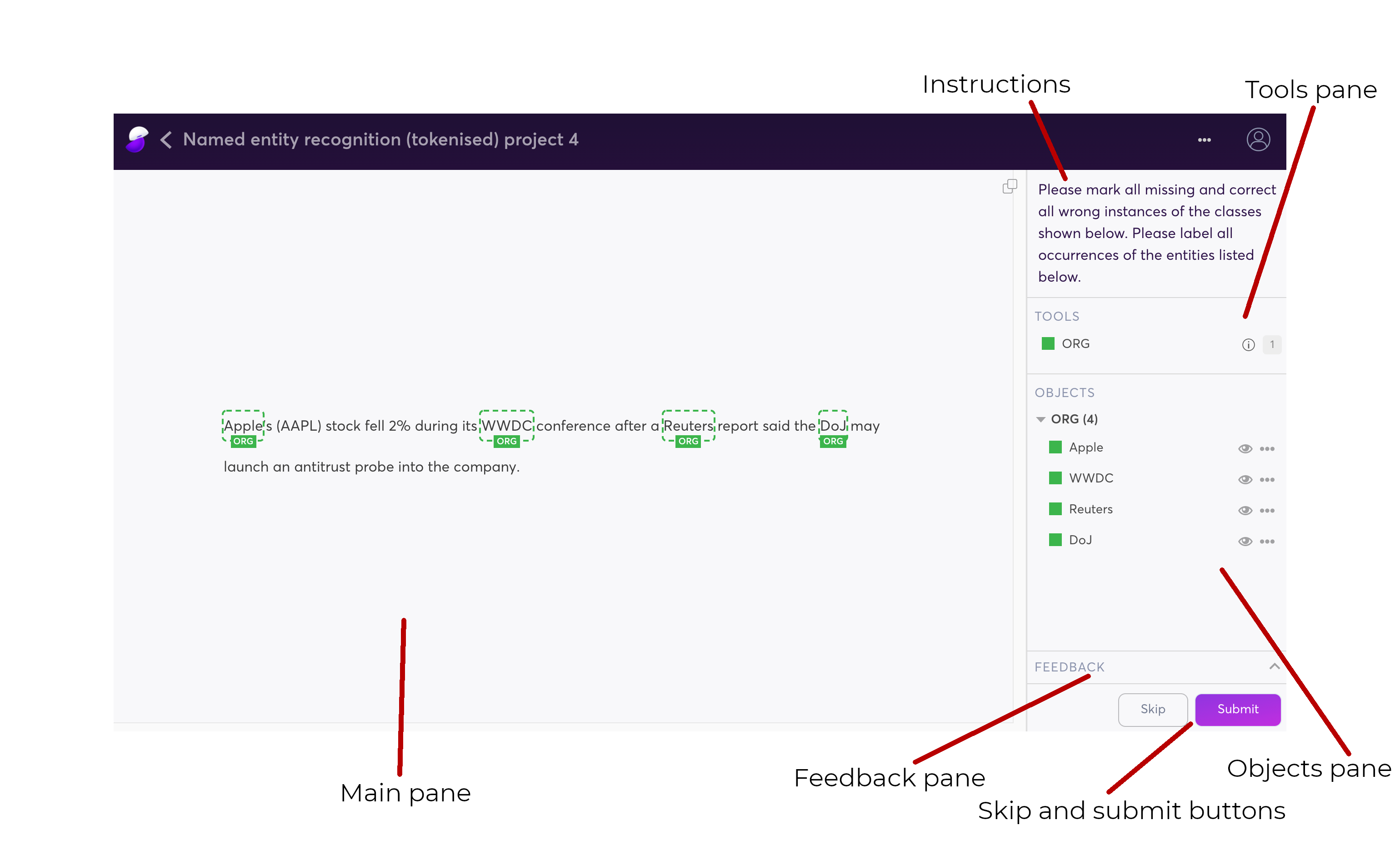Named entity recognition labeling interface
The super.AI labeling interface for named entity recognition (NER) is designed to make entity labeling fast and simple. Below, you can learn in detail about how the interface works and see a list of all the keyboard shortcuts available within the interface to help speed up your labeling.
Overview

The NER labeling interface with the key areas labeled
Getting started
Choose a tool from the tools pane in the top right. Click on a word in the main pane (or click and drag over multiple words) to label it with the chosen tool. Once you have labeled the word or phrase, a corresponding object will appear in the objects pane in the lower right.

An animation showing how to label a phrase
Once you have labeled all the relevant entities, you can click Submit at the lower right.
Editing existing objects
Click on the object in the main pane or the objects pane to select it, then click and drag on the object to move it. Once an object is selected, you can also hover over the edge of the object until you see the cursor change to the two arrows then click and drag to adjust the width of the object.

An animation showing how to edit existing objects
Changing object classes
If you have labeled an object using the wrong class, you can change it any time: just select the object, press C on your keyboard (or click on  to the right of the object and click Change class) and choose the correct class from the list.
to the right of the object and click Change class) and choose the correct class from the list.
Hiding and deleting objects
Hide an object from view by selecting the object and pressing H on your keyboard (or by clicking  Hide besides any object in the objects pane). Hiding objects is useful if there are overlapping objects in the main pane that make it difficult to accurately select, adjust, and create new entities.
Hide besides any object in the objects pane). Hiding objects is useful if there are overlapping objects in the main pane that make it difficult to accurately select, adjust, and create new entities.
Delete an object by selecting the object and pressing delete/backspace on your keyboard (or by clicking  next to an object in the objects pane and clicking Delete).
next to an object in the objects pane and clicking Delete).
Leaving feedback
You can leave feedback on your current task by pressing F on your keyboard (or by clicking Feedback at the lower right of the screen). Once in the feedback pane, you can select a feedback type and leave a brief description of the problem.
If you decide to Skip the task (see the skip section for details) you will need to leave feedback.
Skipping tasks
You can click Skip at the lower right of the labeling interface to skip tasks that are not possible to complete, whether due an input data problem, ambiguous or incomplete instructions, or any other reason. You will be prompted to provide a reason for skipping. Just select a feedback type and enter a brief description of the problem before clicking Confirm skip.
Autosave
Tasks that you are working on in the labeling interface autosave after 5 seconds of inactivity to protect against lost progress. It's possible to disable this feature by expanding the  Options menu and sliding the Save draft automatically toggle off.
Options menu and sliding the Save draft automatically toggle off.
Keyboard shortcuts
You can view the available keyboard shortcuts at any time within the labeling interface by pressing the ? key on your keyboard.
Submit task | Cmd/ctrl + S |
Skip task | Cmd/ctrl + J |
Open/close feedback pane | F |
Show/hide shortcuts | ? |
Select a feedback option (when in feedback pane) | 0–9 |
Select a tool | 1–9, Q, W, E, R, etc. |
Deselect tool | Esc |
Delete selected object | Delete/backspace |
Change class of selected object | C |
Show/hide selected object | H |
Updated 3 months ago
